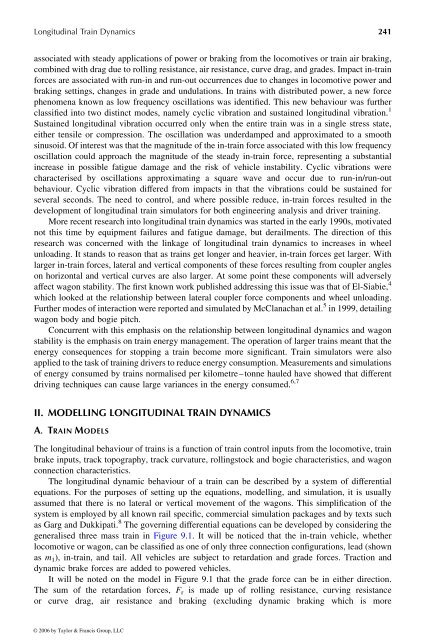Hi-Res PDF - CRCnetBASE
Hi-Res PDF - CRCnetBASE
Hi-Res PDF - CRCnetBASE
You also want an ePaper? Increase the reach of your titles
YUMPU automatically turns print PDFs into web optimized ePapers that Google loves.
Longitudinal Train Dynamics 241<br />
associated with steady applications of power or braking from the locomotives or train air braking,<br />
combinedwith drag due to rolling resistance, air resistance, curve drag, and grades. Impact in-train<br />
forces are associated with run-in and run-out occurrences due to changes in locomotive power and<br />
braking settings, changes ingrade and undulations. In trains with distributed power, anew force<br />
phenomena known aslow frequency oscillations was identified. This new behaviour was further<br />
classified into two distinct modes, namely cyclic vibration and sustained longitudinal vibration. 1<br />
Sustained longitudinal vibration occurred only when the entire train was in asingle stress state,<br />
either tensile or compression. The oscillation was underdamped and approximated to asmooth<br />
sinusoid. Of interest was that the magnitude of the in-train force associated with this low frequency<br />
oscillation could approach the magnitude of the steady in-train force, representing asubstantial<br />
increase inpossible fatigue damage and the risk of vehicle instability. Cyclic vibrations were<br />
characterised by oscillations approximating a square wave and occur due to run-in/run-out<br />
behaviour. Cyclic vibration differed from impacts in that the vibrations could be sustained for<br />
several seconds. The need to control, and where possible reduce, in-train forces resulted in the<br />
development of longitudinal train simulators for both engineering analysis and driver training.<br />
More recent research into longitudinal train dynamics was started in the early 1990s, motivated<br />
not this time by equipment failures and fatigue damage, but derailments. The direction of this<br />
research was concerned with the linkage of longitudinal train dynamics to increases in wheel<br />
unloading. It stands to reason that as trains get longer and heavier, in-train forces get larger. With<br />
larger in-train forces, lateral and vertical components ofthese forces resulting from coupler angles<br />
on horizontal and vertical curves are also larger. Atsome point these components will adversely<br />
affect wagon stability. The first known work publishedaddressing this issue was that of El-Siabie, 4<br />
which looked atthe relationship between lateral coupler force components and wheel unloading.<br />
Further modesofinteraction were reported and simulated by McClanachan et al. 5 in 1999, detailing<br />
wagon body and bogie pitch.<br />
Concurrent with this emphasis onthe relationship between longitudinal dynamics and wagon<br />
stability is the emphasisontrain energymanagement. The operation of larger trains meant that the<br />
energy consequences for stopping atrain become more significant. Train simulators were also<br />
applied to the taskoftraining drivers to reduce energyconsumption. Measurements and simulations<br />
of energy consumed by trains normalised per kilometre–tonne hauled have showed that different<br />
driving techniques can cause large variances in the energy consumed. 6,7<br />
II. MODELLING LONGITUDINAL TRAIN DYNAMICS<br />
A . T RAIN M ODELS<br />
The longitudinal behaviour of trains is afunction of train control inputs from the locomotive, train<br />
brake inputs, track topography, track curvature, rollingstock and bogie characteristics, and wagon<br />
connection characteristics.<br />
The longitudinal dynamic behaviour of atrain can be described by asystem of differential<br />
equations. For the purposes of setting up the equations, modelling, and simulation, it is usually<br />
assumed that there is no lateral or vertical movement of the wagons. This simplification of the<br />
system is employed byall known rail specific, commercial simulation packages and by texts such<br />
as Garg and Dukkipati. 8 The governing differential equations can be developed by considering the<br />
generalised three mass train in Figure 9.1. Itwill be noticed that the in-train vehicle, whether<br />
locomotive or wagon,can be classified as one of only three connection configurations, lead (shown<br />
as m 1 ), in-train, and tail. All vehicles are subject to retardation and grade forces. Traction and<br />
dynamic brake forces are added to powered vehicles.<br />
It will be noted onthe model inFigure 9.1 that the grade force can be in either direction.<br />
The sum of the retardation forces, F r is made up of rolling resistance, curving resistance<br />
or curve drag, air resistance and braking (excluding dynamic braking which is more<br />
© 2006 by Taylor & Francis Group, LLC









